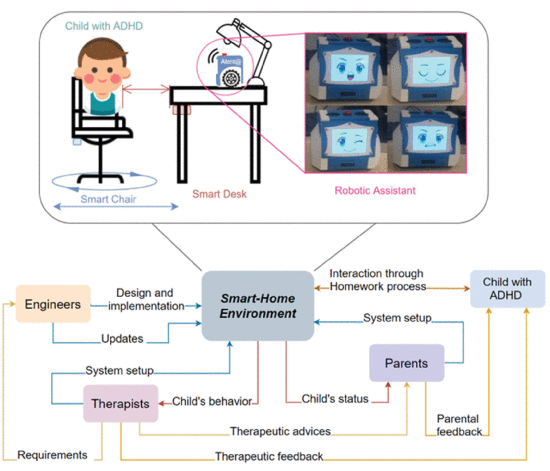ADHD is a chronic condition affecting millions of children that often persists into adulthood. It includes a combination of persistent problems, such as difficulty maintaining attention, hyperactivity, and impulsive behavior. Its symptoms can cause that, for children who suffer from it, it has an additional complication to carry out daily activities, such as successfully maintaining attention in class.
To avoid the complications that occur in the day-to-day life of these minors, a team made up of the UPM and the URJC has developed the robotic assistant Atent @ s, which helps them to be more independent in carrying out their schoolwork. The robot affects their difficulties, contributing to clinical improvement and the well-being of the minor and his family. The results of the study have been positive. As Nuria Máximo, project researcher and professor of Occupational Therapy at URJC explains, thanks to the use of the robot in carrying out tasks, from the third week on, “the appearance of parameters associated with ADHD in children with and without suspicion is reduced of this disorder ”.
The virtual assistant consists of a series of intelligent objects that are attached to everyday furniture, such as a desk or chair, and that allow monitoring the behavior of minors with ADHD during an activity in the daily life of any child. These objects are connected to a robot that collects and analyzes its different actions, and then interacts with it according to the guidelines of interest established by the therapists within the activity being considered. Likewise, the information is stored in a monitoring “repository” that is available to people involved in the minor's daily life, such as their family members, therapists or teachers.
In any case, the integrated objects are invisible to the child, who only has the robotic assistant as an element of interaction. A robot that will establish a limited dialogue with the minor, oriented to carry out small interventions in their condition so that they can refocus on the activity they were doing.
The study has a positive impact on minors with and without ADHD
This robotic assistant, intended to provide therapeutic support in the performance of school tasks by minors with ADHD, is an evolution of a previous version. All the improvements it presents have been made according to the knowledge acquired, as well as the feedback provided by therapists, parents and children. “This version of the robotic assistant seeks to optimize the functionality and physical aspects of the previous design. In addition, it aims to increase the efficiency of the robot compared to its predecessor in technical and functional terms. For this second version, several improvements have been made in the "electronic aspects, in the assembly design and in the programming algorithms," says Santiago Berrezueta, a researcher at the UPM.
The study, the results of which have already been published, has tried to test the feasibility of this second version of the robotic assistant by working with children outside the laboratory. It is an experimentation focused on the academic setting. The experimentation process was carried out with minors who, due to the COVID-19 pandemic, are receiving the accompaniment of an expert educator in a makeshift place to support tasks within a company. "Here the children of company workers can attend online classes while their parents work, also doing their homework in the afternoon", highlights the URJC researcher. “While they solve their homework, an expert educator with experience in the education of children with special abilities offers support and help to the minors if they need it. Until the time of the experiment,
After analyzing the individual parameters, it was observed that the level of distraction of children with suspected ADHD was higher than that of those without suspicion of this disorder. However, the overall result is encouraging. As professor Nuria Máximo points out: “technology must continue to evolve and add other smart objects to it. The important thing is that, thanks to the use of the robot, the child learns to plan the task, start, maintain and end the activity ”.

For the moment, the application of this assistant has focused on school tasks, but the research team also hopes to be able to do so in other activities of the children's daily lives.